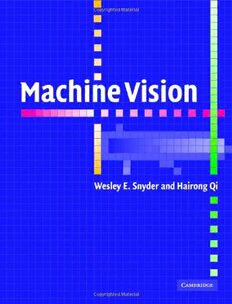
Machine Vision PDF
Preview Machine Vision
This page intentionally left blank MACHINE VISION Thisbookisanaccessibleandcomprehensiveintroductiontomachinevision.Itprovidesall thenecessarytheoreticaltoolsandshowshowtheyareappliedinactualimageprocessing andmachinevisionsystems.Akeyfeatureistheinclusionofmanyprogrammingexercises thatgiveinsightsintothedevelopmentofpracticalimageprocessingalgorithms. The authors begin with a review of mathematical principles and go on to discuss key issues in image processing such as the description and characterization of images, edge detection, feature extraction, segmentation, texture, and shape. They also discuss image matching,statisticalpatternrecognition,syntacticpatternrecognition,clustering,diffusion, adaptive contours, parametric transforms, and consistent labeling. Important applications aredescribed,includingautomatictargetrecognition.Tworecurrentthemesinthebookare consistency(aprincipalphilosophicalconstructforsolvingmachinevisionproblems)and optimization(themathematicaltoolusedtoimplementthosemethods). Software and data used in the book can be found at www.cambridge.org/9780521830461. Thebook isaimed atgraduatestudentsinelectricalengineering,computerscience, and mathematics. It will also be a useful reference for practitioners. wesleye. snyder receivedhisPh.D.fromtheUniversityofIllinois,andiscurrently ProfessorofElectricalandComputerEngineeringatNorthCarolinaStateUniversity.Hehas writtenover100scientificpapersandistheauthorofthebookIndustrialRobots.Hewas a founderofboth the IEEE Roboticsand Automation Society and the IEEE Neural Networks Council. He has served as an advisor to the National Science Foundation, NASA, Sandia Laboratories, and the US Army Research Office. hairong qi receivedherPh.D.fromNorthCarolinaStateUniversityandiscurrentlyan Assistant Professor of Electrical and Computer Engineering at the University of Tennessee,Knoxville. MACHINE VISION Wesley E. Snyder NorthCarolinaStateUniversity,Raleigh Hairong Qi UniversityofTennessee,Knoxville cambridge university press Cambridge, New York, Melbourne, Madrid, Cape Town, Singapore, São Paulo, Delhi, Dubai, Tokyo, Mexico City Cambridge University Press The Edinburgh Building, Cambridge cb2 8ru, UK Published in the United States of America by Cambridge University Press, New York www.cambridge.org Information on this title: www.cambridge.org/9780521169813 © Cambridge University Press 2004 This publication is in copyright. Subject to statutory exception and to the provisions of relevant collective licensing agreements, no reproduction of any part may take place without the written permission of Cambridge University Press. First published 2004 First paperback edition 2010 A catalogue record for this publication is available from the British Library Library of Congress Cataloging in Publication Data Snyder, Wesley E. Machine vision / Wesley E. Snyder and Hairong Qi. p. cm. ISBN 0 521 83046 X 1. Computer vision. I. Qi, Hairong, 1970. II. Title. TA1634.S69 2004 006.37 – dc21 2003053083 isbn 978-0-521-83046-1 Hardback isbn 978-0-521-16981-3 Paperback Cambridge University Press has no responsibility for the persistence or accuracy of URLs for external or third-party internet websites referred to in this publication, and does not guarantee that any content on such websites is, or will remain, accurate or appropriate. To Graham and Robert WES To my parents and Feiyi HQ Contents Totheinstructor page xv Acknowledgements xviii 1 Introduction 1 1.1 Concerningthisbook 1 1.2 Concerningprerequisites 2 1.3 Someterminology 3 1.4 Organizationofamachinevisionsystem 5 1.5 Thenatureofimages 6 1.6 Images:Operationsandanalysis 6 Reference 7 2 Reviewofmathematicalprinciples 8 2.1 Abriefreviewofprobability 8 2.2 Areviewoflinearalgebra 10 2.3 Introductiontofunctionminimization 15 2.4 Markovmodels 20 References 28 3 Writingprogramstoprocessimages 29 3.1 ImageFileSystem(IFS)software 29 3.2 Basicprogrammingstructureforimageprocessing 31 3.3 Goodprogrammingstyles 32 3.4 Exampleprograms 33 3.5 Makefiles 34 4 Images:Formationandrepresentation 38 4.1 Imagerepresentations 38 4.2 Thedigitalimage 42 vii viii Contents 4.3 Describingimageformation 49 4.4 Theimageasasurface 51 4.5 Neighborhoodrelations 53 4.6 Conclusion 56 4.7 Vocabulary 56 Topic4A Imagerepresentations 57 4A.1 Avariationonsampling:Hexagonalpixels 57 4A.2 Othertypesoficonicrepresentations 60 References 62 5 Linearoperatorsandkernels 65 5.1 Whatisalinearoperator? 65 5.2 Applicationofkerneloperatorsindigitalimages 66 5.3 Derivativeestimationbyfunctionfitting 69 5.4 Vectorrepresentationsofimages 73 5.5 Basisvectorsforimages 75 5.6 Edgedetection 76 5.7 Akernelasasampleddifferentiablefunction 78 5.8 Computingconvolutions 83 5.9 Scalespace 85 5.10 Quantifyingtheaccuracyofanedgedetector 88 5.11 Sohowdopeopledoit? 90 5.12 Conclusion 92 5.13 Vocabulary 92 Topic5A Edgedetectors 97 5A.1 TheCannyedgedetector 97 5A.2 Improvementstoedgedetection 98 5A.3 Inferringlinesegmentsfromedgepoints 99 5A.4 Space/frequencyrepresentations 99 5A.5 Vocabulary 101 References 104 6 Imagerelaxation:Restorationandfeatureextraction 107 6.1 Relaxation 107 6.2 Restoration 108 6.3 TheMAPapproach 111 6.4 Meanfieldannealing 115
